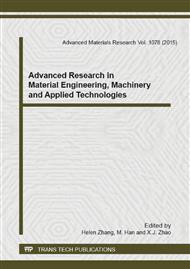p.8
p.12
p.20
p.25
p.31
p.36
p.40
p.45
p.49
Characterization of Zirconia Sizing Nozzle Modifying Addictives Preparated by Sol-Gel Method
Abstract:
MgO-Al2O3-ZrO2 composite powders with 3 kinds of mass ratio were synthesized by sol–gel method using MgCl2·6H2O, AlCl3·6H2O and ZrOCl2·8H2O as starting materials, and NH3·H2O as a precipitant. The composite powders which match with zirconium oxide particle size and evenly distribute can are advantageous to the formation of metastable t-ZrO2 and restrain the grain growth as the additive of modified sizing nozzle. Chemical composition, mineral phase, particle size distribution and micro-morphology of the composite powders were investigated by X-ray fluorescence instrument, X-ray diffractometer, laser particle size analyzer and scanning electron microscope. Research showed that under the process that the concentration of MgCl2 solution 0.2 mol/L, AlCl3 and ZrOCl2 solution concentration 0.5 mol/L, the pH controlled between 10 ~ 11, PEG as the surfactant, drying at 70°C±5°C, heat treatment temperature at 800°C for 3h, particle size distribution of MgO-Al2O3-ZrO2 composite powders were: d10 = 1.28 μm, d50 = 4.65μm, d90 = 11.13μm (MgO 10%); d10 = 1.15μm, d50 = 5.80μm, d90 = 15.13μm (MgO 15%);d10 = 1.21μm, d50 = 6.59μm, d90 = 16.87μm (MgO 20%). With the rising of heat treatment temperature, the crystallization degree of composite powders increased, at 800 °C a small amount of t - ZrO2 precipitated, meanwhile MgO and Al2O3 are still in the amorphous phase. The MgO-A12O3-ZrO2 composite powders under this condition have high reactivity and uniform distribution.
Info:
Periodical:
Pages:
31-35
Citation:
Online since:
December 2014
Authors:
Price:
Сopyright:
© 2015 Trans Tech Publications Ltd. All Rights Reserved
Share:
Citation:


